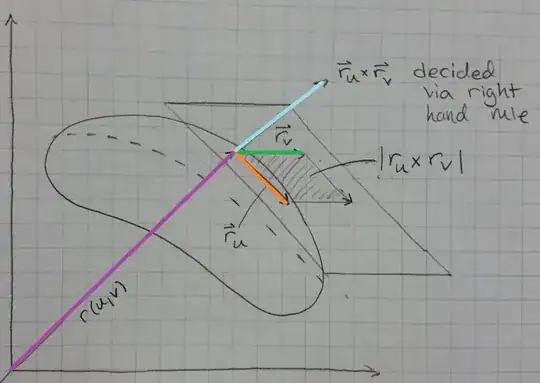P1086: For a closed surface, the positive orientation is the one for which the normal vectors point outward from the surface, and inward-pointing normals give the negative orientation.
P1087: If $S$ is a smooth orientable surface given in parametric form by a vector function $\mathbf{r}(u,v)$, then it is automatically supplied with the orientation of the unit normal $\mathbf{n} = \cfrac{\partial_u\mathbf{r} \times \partial_v\mathbf{r}}{\vert \partial_u\mathbf{r} \times \partial_v \mathbf{r} \vert} $...
P1093: The orientation of a surface S induces the positive orientation of the boundary curve C shown in the figure. This means that if one walks in the positive direction around the curve with one's head pointing in the direction of $\mathbf{n}$, then the surface is always on one's left.
How does one determine whether $\partial_{\huge{u}}\mathbf{r} \times \partial_{\huge{v}}\mathbf{r} \quad \text{ or } \quad \partial_{\huge{v}}\mathbf{r} \times \partial_{\huge{u}}\mathbf{r} \quad $ (negatives of each other) matches the desired orientation?
Since a surface may be hard to sketch (especially under exam conditions), I was hoping for an argument that isn't geometric or visual. But if geometry and visualisation are the easiest, would you please provide pictures for your explanations?
P1091 16.7.$23 \text{ generalised.}$ $\mathbf{F} = (x,-z,y)$ and $S$ is the part of $x^2 + y^2 + z^2 = p$ in the first octant and oriented towards $(0,0,0)$. Evaluate the surface integral $\iint_S \mathbf{F} \cdot d\mathbf{S}$. For closed surfaces, use the positive (outward) orientation.
Solution: Since $S$ is a sphere, parameterize with $r(\theta, \phi) = (p\sin \theta \cos \theta, p \sin \theta \sin \theta, p \cos \phi)$.
Then $\mathbf{F[r(\theta, \phi)]} \cdot \color{red}{(\partial_{\theta} r \times \ \partial_{\phi} r )} = p^3 \sin^3 \theta \cos^2 \theta \qquad (♦)$
Then $\iint_S \mathbf{F} \cdot d\mathbf{S} = \iint_D \mathbf{F} \cdot (\partial_{\theta} r \times \ \partial_{\phi} r ) \, dA = p^3\int^{2\pi}_0 \cos^2 \theta \, d\theta \int^{\pi/2}_9 \sin^3 \phi \, d\phi = ... = p^3 \quad \pi \quad 1/3.$
The answer is given as $ -p^\color{red}{2} \quad \pi \quad 1/3 $.
How would've one determined that the cross product in (♦) coloured in red is wrong,
and that it should've been $\color{green}{ \partial_{\large{\phi}} r \times \partial_{\large{\theta}} r }$ ?
Predicated on user Dan's Answer: 